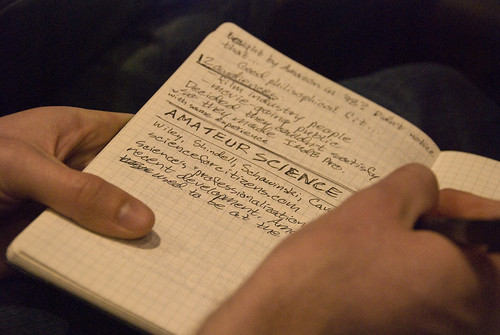As much as I dislike sitting down and crafting a completed writing product, I love writing to learn.
Writing to learn adds  to my understanding of content. As a student writing notes was an important part of my ability to do well on tests. I wanted to be a good student and please my teachers. My notes may not make sense to anyone else but they continue to be an important part of my understanding. As I have gotten older my notes have more scribbles, symbols, arrows, bullets and I use a variety of colored pens. These notes look different but are still very important and when I need to go back and check on something – the color pen I used is usually the first thing that comes to mind.
to my understanding of content. As a student writing notes was an important part of my ability to do well on tests. I wanted to be a good student and please my teachers. My notes may not make sense to anyone else but they continue to be an important part of my understanding. As I have gotten older my notes have more scribbles, symbols, arrows, bullets and I use a variety of colored pens. These notes look different but are still very important and when I need to go back and check on something – the color pen I used is usually the first thing that comes to mind.
I was the first science teacher in my area to apply and be accepted into the Writing Project. Participating in this project was one of the milestones of my teaching career. The biggest thing it did for me was give me a deeper understanding of the importance of feedback. Feedback needs substance but it can be brief and to the point. Number Two was the discovery of Learning Logs and the potential value in the science classroom.
The science notebook wasn’t working for me. I wanted students to have access to information over a period of time but the notebook seemed to be just a collection of papers not the important personal information I thought students needed.
Stenographers notebooks and composition books were my Learning Logs of choice and I never decided which was the best. Both have pluses and minuses and I traded back and forth between grading periods and sometimes entire years. Every grading period we started fresh with a new Learning Log and it was a running record of what we accomplished. I liked the permanent line down the middle of each page in the steno book because I could have students reflect on one side and then I could respond with my feedback on the other. I could have students respond to something they were reading by taking notes on one side and asking questions on the other. This Double Entry journaling worked very well but I didn’t have a name for what we were doing until many years later.
Students completed or  placed their sponge activities, admit/exit slips, data collection, hypothesis formulation, conclusion writing, procedure listing, problem solving, note taking, etc in their learning logs on a daily basis. Pages were never to be torn out and thrown away. Scientists keep notebooks like this. They aren’t necessarily neat and beautiful, they are written with different colored pens, important items are taped and pasted where needed, more than one person’s writing is evident, and they become treasures. Most scientists have a few of these hidden in a safe place.
placed their sponge activities, admit/exit slips, data collection, hypothesis formulation, conclusion writing, procedure listing, problem solving, note taking, etc in their learning logs on a daily basis. Pages were never to be torn out and thrown away. Scientists keep notebooks like this. They aren’t necessarily neat and beautiful, they are written with different colored pens, important items are taped and pasted where needed, more than one person’s writing is evident, and they become treasures. Most scientists have a few of these hidden in a safe place.
Learning logs were never graded. This is where the students practiced and practicing is a must for a scientist. One of my class mantras any student could repeat was: Once is never enough; two, three or one hundred times would be much better. This doesn’t mean that I didn’t look at what students were doing or that I didn’t check on something periodically. Learning logs were used by students’ everyday and I viewed them in some capacity each day. I responded to questions, I checked answers and wrote additions and corrections with the students and sometimes I went through the classroom placing checkmarks in each notebook in order to record that each student had complete understanding of an assignment. The constant daily use of the learning logs were my formative assessments. This is how I kept check on the pulse of the classroom. Most of the time there was a constant steady beat with the occasional frustrated student or group of students that needed more consistent monitoring. Occasionally there was a rapid pulse, students would be scribbling furiously when taking notes. They didn’t want to forget a single thing and they were desperately working to get everything down correctly in their notebook. These were exciting times, students were engaged in what they were learning and understood the importance of taking notes for future reference. Students were encouraged to use the information in their logs when we were having group or class discussions. Students were taught that their responses and understandings were valued but they had to have evidence to back up what they were saying.
If you haven’t tried using a learning log I would suggest you give it a whirl. I will gladly work with you and answer any questions you might have.
